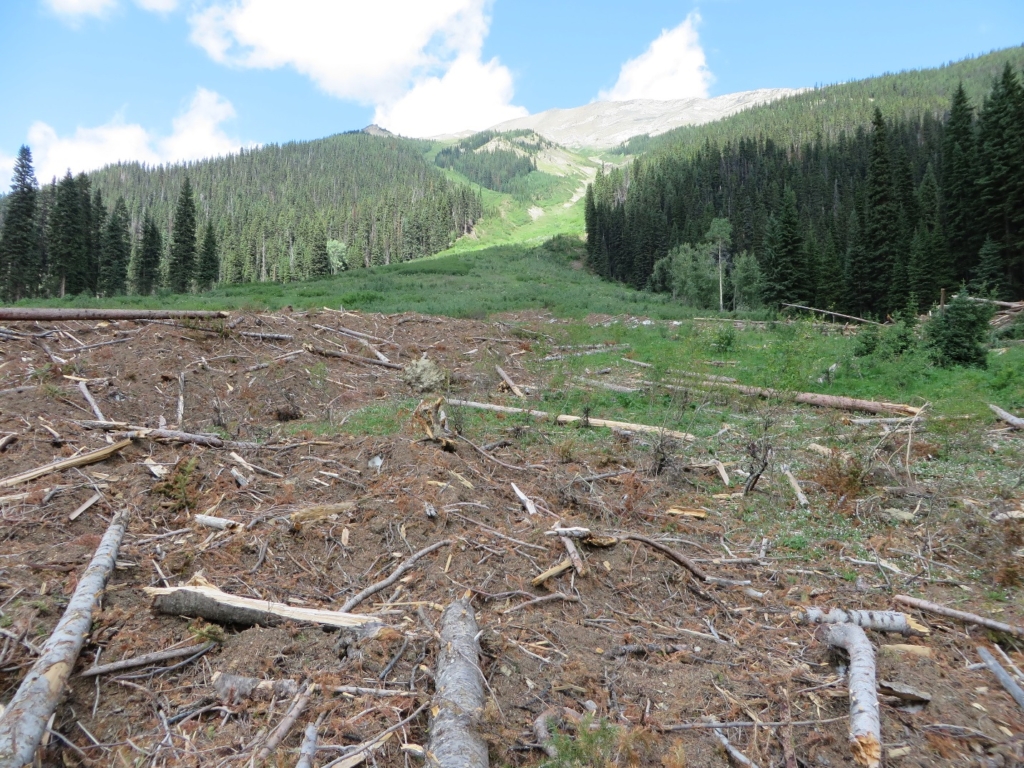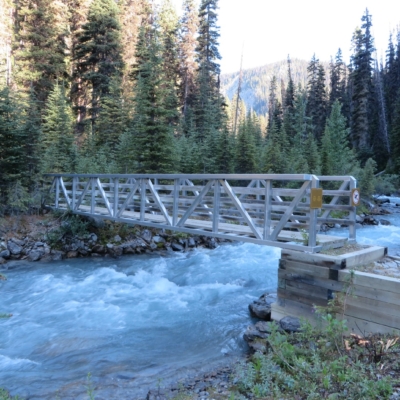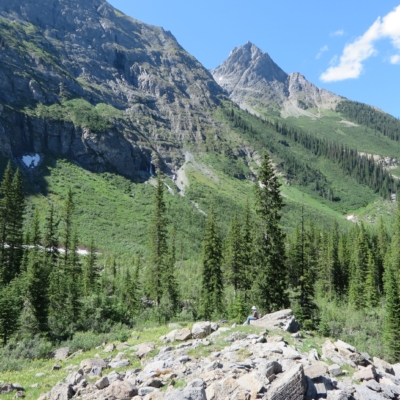Kootenay Park
dude
Kootenay National Park Adventure: Helmet Falls to Floe Lake
Monday, July 24th, 2017
Our Kootenay Park adventure in British Columbia was over almost before it began. We had booked it well in advance, and at first all seemed well. Our plan was to spend four nights on this trip, with the objective of seeing the Rockwall in good weather. We had hiked most of the same trails the year before, but the weather had not cooperated. The famous Rockwall had been shrouded in cloud, and we felt we had not been able to appreciate it the way we would like to have done.
Then emails began to arrive from the park office. It had been a rough winter in the Rocky Mountains, with unusually deep snow. Avalanches and floods had destroyed some key bridges on our route, and we had a choice of cancelling our trip completely, or extending it to five nights and summiting two additional high passes in addition to our planned Rockwall Pass. This was all because we could not exit the park the way we had planned down the Tumbling Creek Trail due to a damaged bridge. We would have to go much further and exit through the Floe Lake Trail.
We decided to bite the bullet, and extend our trip. Even as it was, there was still one major damaged bridge on our route, which meant we would have to ford deep and cold Helmet Creek. Initially reports were of waist-deep water, but eventually word came that a short distance above the damaged bridge, one could ford where the water was only knee deep. This we thought we could do.
The park also issued warnings about massive piles of logs, snow, and other debris on the trails where avalanches had crossed it. As if this was all not enough, about a week before our planned departure, forest fires struck Kootenay Park, and large sections of the park were closed.
Fortunately, the fires and smoke were in the southwestern part of the park, and when our appointed day for departure came, we left Calgary as planned for the trailhead. We even thought we had the somewhat complicated logistics under control. On the back on our Jeep was my older bicycle. The plan was to stop at the trailhead at the Paint Pots, leave my wife and our heavy back packs there, and then I would drive on to where our hiking route came back to the highway, the Floe Lake parking lot. I would leave the Jeep there and ride my bicycle a long 13 uphill kilometres back to Paint Pots, lock the bicycle in the bush somewhere, and we would hit the trail.
As things turned out, luck was with us. We had taken the bicycle off the carrier in the Paint Pot parking lot and put it in the car just in case I could get a ride with someone back to the Paint Pots. I could then abandon my Jeep and bicycle in a hurry and join someone should they be driving my way.
The Floe Lake parking lot was very full, but I managed to squeeze my Jeep into the last narrow space. I noticed that four men were standing beside a car not far away, and when I saw one hug the other goodbye, I knew I might be in luck. No doubt some hikers were being dropped off by friends, and these friends might well be driving back to Calgary. I approached them, and a few minutes later I was being given a ride back to the Paint Pots Trailhead. On the way I was regaled with stories of the Cape Scott Trail on Northern Vancouver Island. I resolved that next summer we would have to try that trip.
Fortunately, this good start presaged the whole trip. For the most part, this time, luck was with us. Soon we were across the Vermillion River Bridge and on the trail.

Our trek to the Helmet / Ochre Campground was largely uneventful, although even here on our first day we encountered some of the obstacles we would have to cope with for the next six days. Large trees had fallen across the trail, and to this point park staff had obviously been too busy fixing bridges and fighting forest fires to clear away the “deadfall” on the trail. Some of these fallen trees were a challenge to get over, under, or around with our heavy packs. We also encountered our first avalanche debris field. The avalanches had come down further on the avalanche slopes than usual this winter, and had thrown numerous trees onto the trail. Many of these broken trees were quite large: obviously it had been many years since the avalanches had come this far down the mountainside.
Our first hiking day would be a short one. Soon we came to the simple bridge across Ochre Creek, and to our delight we found we had the entire campground to ourselves. Helmet / Ochre Campground is only a little over six kilometres from the trail head at the Paint Pots, and most hikers skip it and walk straight through to Helmet Falls. We knew we would be off to a late start, however, and decided to stay at Helmet / Ochre. We had a good evening and night there. No one else arrived to join us.
After dinner we hung our food on the cable system provided, admired the very new outhouse, and went to sleep on the very same campsite we had occupied on our trip through here the year before.
Despite my concerns about the upcoming river ford the next day, I slept well. The destruction wrought by the winter on the Kootenay Park trail system was obviously very real. On the way up from the Paint Pots, we had passed by the junction with the Tumbling creek Trail, which had been meant in our initial plans to be our exit from the park. The Tumbling creek Trail entrance had been massively blocked by red tape strung between two trees. This was the Park Service’s way of indicating that one was not to enter. That trail seemed very closed indeed. We were on a long one-way trip to Floe Lake.

























